Tough international and domestic tests await Abe even if he wins. Mollifying US President Donald Trump’s concerns over the US$69 billion US trade deficit with Japan will be his most immediate challenge. Abe hopes to avoid tariffs on Japanese autos while resisting a bilateral trade deal on Trump’s terms. Two tactics stand out so far — arms and energy purchases.
Japan has announced it will purchase the Aegis Ashore missile defence system (US$5.4 billion) and looks likely to add nine more early warning E-2D Hawkeyes (US$3.14 billion) to an original purchase of four units. Tokyo currently has almost US$20 billion in foreign military sales cases active with the United States.
Tokyo has also been working to increase Japan’s purchases of US LNG. And Japan is supporting on-selling of US gas to Asian countries as a further deficit reduction measure. Japanese infrastructure and energy companies together with government-backed agencies are already promoting the regional build-up of power-generation facilities and LNG shipment hubs, as well as offering insurance for sea transport to assist future US natural gas sales through Japan.
Japanese uncertainty about placating Trump will nevertheless motivate Abe to further Japan’s tactical entente with China. Chinese President Xi Jinping and Abe now appear enthusiastic about pushing forward on the ASEAN-centred Regional Comprehensive Economic Partnership (RCEP) to diversify economic options for both nations. With the Comprehensive and Progressive Agreement for Trans-Pacific Partnership and the EU–Japan Economic Partnership Agreement already in Japan’s pocket, this moment represents a good opportunity for Japan to encourage China to agree to a ‘higher quality’ RCEP deal while it acquires further leverage to resist US trade demands.
Given recent implementation and messaging problems, China could also use the practical experience and image improvement that would come alongside cooperation with Japan on its Belt and Road Initiative (BRI). While Japan’s own international connectivity agenda is often painted as a BRI rival, China–Japan cooperation in overlapping geographical and sectorial areas of economic interest could benefit Japan commercially. Unsurprisingly then, Tokyo and Beijing are planning to sign memorandums of understanding on 20 to 30 projects as early as October. Reciprocal leader visits over the next year also look likely.
If accompanied by a reduction in security tensions, China–Japan rapprochement may ameliorate pressure on Japan should Trump escalate the trade dispute — especially if he starts to connect trade to the security alliance. Japanese officials have warned that, unlike the steel tariffs, they would retaliate if the United States applies tariffs to Japan’s auto exports.
Domestically, a targeted overhaul of Japan’s social security system and increasing labour force participation will occupy Abe’s attention. Abe wants to facilitate earlier re-entry of young parents to the workforce through greater preschool funding, increasing foreign worker numbers and extending the longevity of the current workforce through optional pension delays. Abe expects such measures to generate higher taxation and social security receipts, while proposed support for tertiary education — a major future burden hanging over the heads of Japanese parents — is expected to help drive private consumption.
But the 2019 upper house election could complicate the implementation of Abe’s domestic agenda, as well as constitutional revision of the war-renouncing Article 9.
A large majority of the seats up for election in 2019 are those won by the LDP in mid-2013 when Abe was at peak popularity, the opposition was in absolute disarray and the public wanted to end to the ‘twisted Diet’ scenario that had plagued Japanese politics between 2007 and 2012. But with Abe’s popularity waning over time, and with improved opposition electoral coordination, the LDP did not win a majority of the seats contested in the 2016 upper house election.
A repeat of 2016 will result in the LDP losing seats and its upper house majority, possibly strengthening Komeito’s hand in the coalition. While this is unlikely to dislodge Abe from the leadership ahead of the 2020 Tokyo Olympics, a poorer than expected performance may restrain Abe’s ability to play a big hand in choosing his successor.
Pro-constitutional amendment forces are also likely to lose the two-thirds majority needed to pass an amendment resolution through the upper house prior to a constitutional referendum. While this may explain Abe’s desire to pass an amendment resolution during the late-2018 extraordinary Diet session, Komeito currently appears set on running out the clock on Abe until the 2019 election.
There are also potential negative consequences for Japanese conservatives of a majority ‘No’ vote in any constitutional referendum, including Abe’s likely resignation. Controversies related to revising Article 9 may also complicate the more pressing goal of supplementing Japan’s defence capabilities after the expected revision of the National Defense Program Guidelines in late 2018.
With plenty else on Abe’s plate over the next year, Abe may well eventually be forced to pass on constitutional revision.
Corey Wallace is the Einstein Postdoctoral Fellow at the Graduate School of East Asian Studies, Free University of Berlin.

